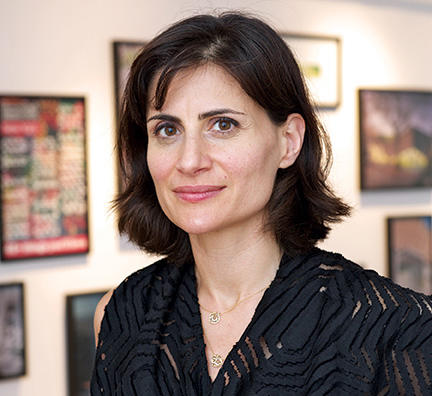Amale Andraos, a New York architect who joined the Columbia faculty three years ago, has become dean of the University’s Graduate School of Architecture, Planning, and Preservation. President Lee C. Bollinger announced her appointment over the summer, and Andraos took up the position September 1.
“An inspiring teacher, a respected colleague, and a pioneering practitioner whose innovative commissions in cities around the world have earned widespread admiration, Amale is a new leader among a rising generation of creative architects and designers of our physical environment,” says Bollinger. “She is just the kind of person who can further expand the role of the school as a center of interdisciplinary thinking across Columbia about how to develop a more just and sustainable society.”
Andraos is a principal at WORKac, an architecture and design firm that she cofounded with her husband, Dan Wood ’92GSAPP, which is known for projects that combine elements of manmade and natural environments. The firm’s designs often feature green roofs, indoor waterways, gardens that float above courtyards, and large openings that blur the line between indoors and outdoors. The firm’s ongoing and recently completed projects include a new conference center in the capital of Gabon; a master plan for seven new university campuses in China; the Blaffer Art Museum at the University of Houston; the Children’s Museum of the Arts in Manhattan; and the Edible Schoolyards educational gardens at PS 216 in Brooklyn and PS 7 in Harlem, where children grow, cook, eat, and compost organic food, working between an outdoor garden and a small building that combines a greenhouse and a kitchen-classroom.
“A structure can make you feel connected to the world, rather than sheltered from it,” she says. “In the ‘Edible Schoolyards,’ the roof collects rain and distributes it to the garden; this is something the children can see and understand. The slope of the roof and the shape of a water cistern below are communicating something about how architecture and the environment can work together.”
A native of Lebanon, Andraos attended the McGill University School of Architecture in Montreal and the Harvard Graduate School of Design. Before cofounding WORKac in 2003, she worked with the acclaimed architect Rem Koolhaas in his Rotterdam and New York offices. She has taught at Princeton, Harvard, the University of Pennsylvania, the Parsons School of Design, the New York Institute of Technology, Ohio State’s Knowlton School of Architecture, and the American University of Beirut, in addition to Columbia.
Andraos is a leading voice on urbanism and globalization — especially as they relate to environmental and social concerns. These interests have led her to become deeply involved in Columbia’s international programming, serving on the faculty steering committee of the Columbia Global Centers in Amman and Istanbul, teaching a design studio and seminar at GSAPP’s Studio-X in Amman, and organizing a symposium on the concept of “the Arab city” in Amman last fall. (A similar symposium will take place at GSAPP’s Wood Auditorium on November 21.)
“What interests me about the notion of the Arab city is how Western architects and planners still fall back on clichés when thinking about places that are exotic to them,” she says. “If we work in a city like Amman, or in any ‘non-Western’ city, for that matter, we tend to assume that our work should necessarily say something meaningful about that region’s cultural identity, and the result is often quite reductive. Most cities’ needs aren’t any different from our own. They need creative solutions to problems involving density, water distribution, energy efficiency, and sustainability, just as all cities do.”
Andraos, who succeeds Mark Wigley as dean, says she is determined to help GSAPP faculty collaborate with scholars from across the University to address a wide range of pressing global issues — everything from public health to water security to flood control to education.
“Columbia is already a leader in addressing the challenges of high-speed urbanization around the globe, and I believe it can lead in recasting architecture at the heart of the dialogue between urban societies and the natural environment,” says Andraos. “This is a school whose creativity and diversity of global perspectives make it an ideal place to consider these large issues, and I am honored by the opportunity to expand on the work that Mark Wigley has done in welcoming people like me to the conversation.”



